CHINES ECONOMY
LIST
UNIT 8. LABOR AND HUMAN CAPITAL
UNIT 9. LIVING STANDARDS
UNIT 8
LABOR AND
HUMAN CAPITAL
8.1 The institutional transformation of Chinese labor
8.1 The institutional transformation of Chinese labor
P.182
8.1.2 Employment: Ownership and Labor Mobility
The government assumed direct control over all urban hiring. ( They took authority to hire and fire away from individual enterprises
Voluntary job mobility within urban areas disappeared.
This complete absence of labor markets was an extraordinary feature of the Chinese command system.
The extra rigidity of labor markets grew out of the effort to control population movement and employment after the GLF
In the 1960~1970s : There was virtually no labor mobility .
After the collapse of the GLF, mobility of all kinds, including job mobility, declined sharply.
8.1 The institutional transformation of Chinese labor
8.1.2 Employment: Ownership and Labor Mobility
8.1 The institutional transformation of Chinese labor
P.182
8.1.2 Employment: Ownership and Labor Mobility
Thereafter, the Chinese government began to give greater legitimacy and legal protection to private enterprise.
As of 2003, almost 5% of the Chinese labor force works for the government-run PSUs.
Deducting government and public enterprise workers, more than 80% of China’s workers work for the private sector.
Both in urban and rural areas are an extremely important part of labor markets.
Through the mid-1990s, the features of the first phase of china’s gradualist transition strategy were very much in evidence.
This whole institutional setup changed dramatically. SOEs began laying off redundant workers.
8.1 The institutional transformation of Chinese labor
8.1.2 Employment: Ownership and Labor Mobility
8.1 The institutional transformation of Chinese labor
P.184
8.1.3 Employment, Unemployment, and State-Sector Downsizing
At the beginning of the reform era (1978-1979), millions of the “sent down” youth returned to the city and had to find work.
During the mid-1990s the dramatic acceleration of labor reforms began with the determination of tackle the problem of overmanning in SOEs.
New categories of workers : the “surplus worker” and subsequently, “off-post” or “laid-off” (xiagang) worker.
WHAT is 下 Xiagang ?
The Chinese language xiagang means “not on sentry duty”
but the word is now widely used as a special term to indicate circumstances where a worker is no longer “on duty”
in his or her work unit.
Warner and Zhu (2000) describe xiagang as internal unemployment,
which occurs when SOEs are downsized and the employees
for whom there is no longer work are provided with a stipend and entitlements such as housing and medical benefits.
Xiagang was designed to fit the special circumstances of the transitional economy and avoid the distinguished the Russian model.
The process was quite different from redundancy
in advanced industrial economies.
The SOE retained a concrete set of obligations to laid off
employees as well as a formal, albeit pared down,
labor relationship for a maximum period of three years.
8.1 The institutional transformation of Chinese labor
P.187
8.1.3 Employment, Unemployment, and State-Sector Downsizing



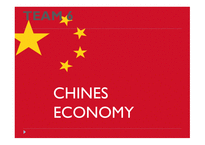
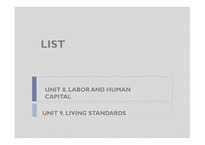
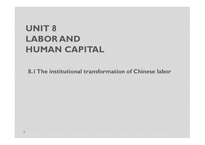
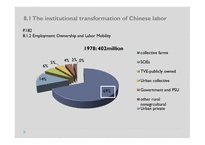



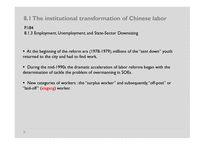




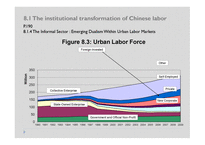
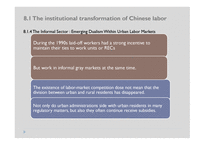




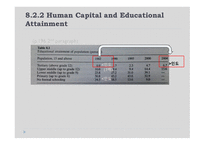
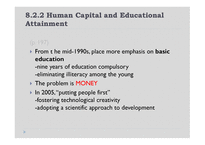
 분야
분야


